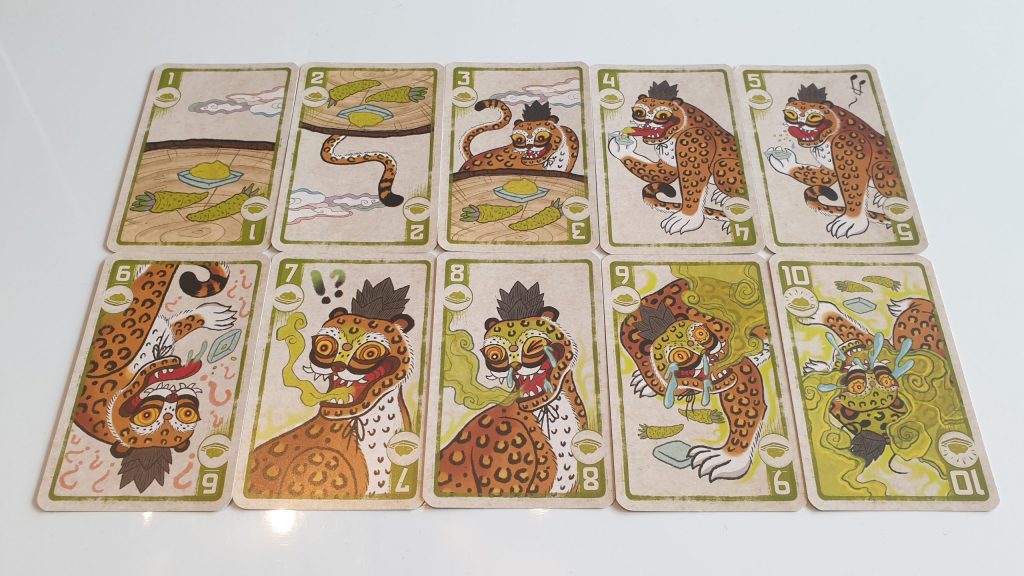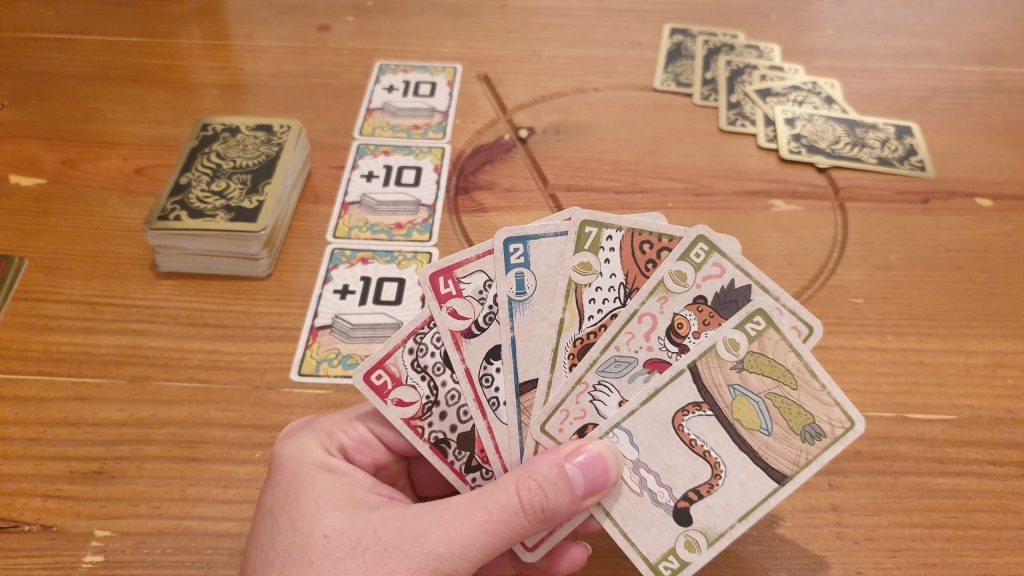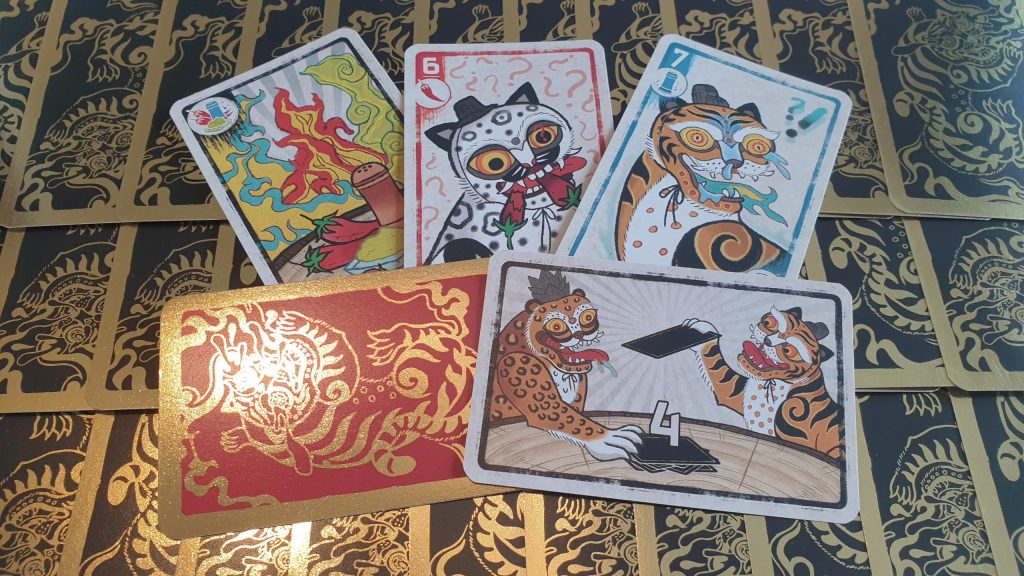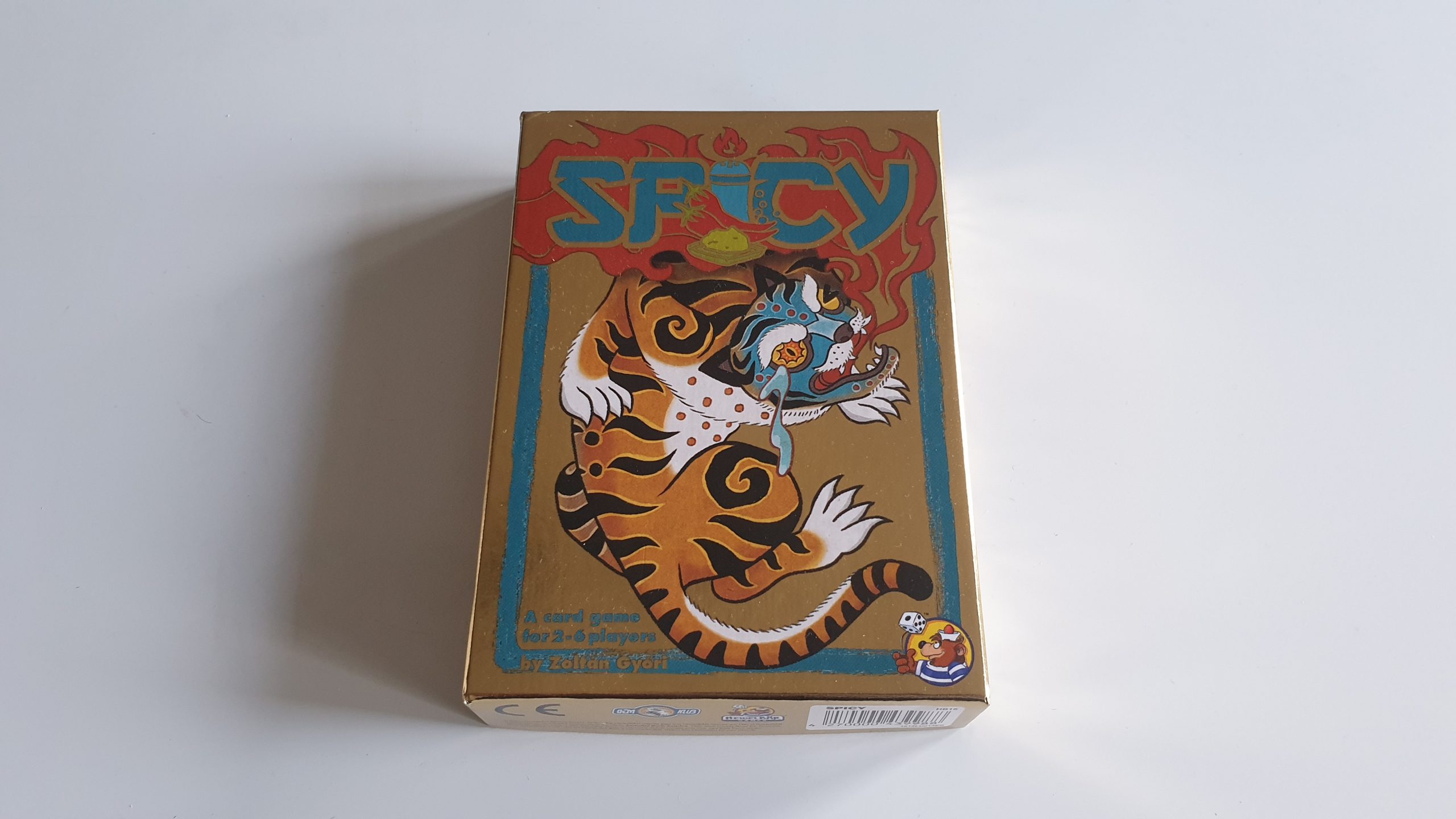Spicy is a brand new bluffing based card game from publisher HeidelBÄR Games. Designed by Győri Zoltán Gábor, featuring artwork for Jimin Kim, the game is about a contest between three big cats taking on a hot spice contest. In around 10 – 15 minutes, 2 – 6 players will play chili, wasabi and pepper cards in an aim to become the top cat. However, is the gameplay as on fire as the cat’s mouths from the spice? Let’s find out!
Shuffling the 100 card spice deck each player is dealt 6 cards at random, with three trophy cards placed in the middle of the table. Spice cards are mostly valued between 1 – 10 and come in 1 of the 3 suits: chili, wasabi and pepper. Also in the deck, there are a few special cards that are wild numbers without a suit or a wild suit without a number. A unique World’s End card is held up against the spice deck and slid into the deck, at the height indicated by the player count, ready to trigger the end of the game. If players want to use a Spice It Up card this would be the time to reveal one, otherwise for the basic game it is time to play!
At the beginning of each round the starting player plays any card from their hand face down to the center of the table. They must declare that the card is of value 1 – 3 and specify a suit, and this information can be truthful or a bluff. Going clockwise around the table players then take it in turns to play a card face down from their hand, stating a higher number but of the same suit. For example, if the starting card was “Pepper 2” the second player could say they have played a “Pepper 8”. Importantly, the card played never has to match what was said.

The highest value that the cards go up to is 10. Once a 10 has been declared the round continues with the next player starting back at values of 1 – 3, still following the suit. At any point a player can decide not to play a card, instead drawing a card from the deck. Getting rid of cards can be a route to victory, so you’ll not want to do this too regularly.
While there are multiple copies of each number and suit combination in the deck, at times players will get the feeling that an opponent has bluffed. At any point until a new card has been played other players can challenge the top card of the pile. When challenging, the challenger must state whether they think it is the number or the suit that the player has bluffed, even if they believe it to be both. If correct, the challenger claims all of the cards played as a face up stack in front of them – as points for the end of the game. In this case the challenged player would also gain two cards as a penalty, though they start the new round. If the challenger was incorrect they’d get the penalty cards, plus the challenged player would gain the stack of cards as points!
Players don’t draw new cards after playing one, so over time their options dwindle – making bluffing more likely. If they manage to play all of their cards, and are either not challenged on their final card or win the challenge, they gain a trophy. They will then redraw a hand of six cards before the game continues. The game ends when one player gains a second trophy, instantly winning them the game, or if all three trophies are claimed. The game also ends when the world end card surfaces on the top of the spice deck. If this is the case then the win is decided by points. Each trophy is worth 10 points, every card in your face up stack is worth 1 point and cards still in your hand at the end of the game are worth -1 point. Whomever has the most points is the top cat!
Bluffing as a genre simply doesn’t click with some players. For those that dislike bluffing as they give themselves up by laughing or pulling a face Spicy might still be the game for you. Even when a player correctly calls your bluff, the challenger must still state if it is the number or suit that you’re lying about. This means there is always a chance to win. The pacing of Spicy is very fast though, so players will need to be able to think on their feet. Rounds must start with cards valued 1 – 3 but then the numbers can instantly jump in a flash – with no maximum step between values. This can mean a card you are about to play becomes too low, forcing players into a bluff. Therefore, if it is the feeling of being forced to bluff Spicy may still not be for you.

During play the pile of cards in the middle will grow, and this slowly but surely ups the ante, and by extension the tension. You’ll start to doubt every card that players put down, though actually calling something out as a bluff can seem so risky. After a few games a sub-game meta can start with players becoming more ballsy and confident, even bluffing on cards at the start of a round – only for them to eventually be called out for it. It all builds together to craft an entertaining experience, and distrust between friends and family – in a banter sort of way.
Spicy comes with a player count of 2 – 6 on the box. While with two the game can feel slightly back and forth, the game flows well with speedy turns regardless of the player count. Even at the full count of 6, players are always involved – with anyone able to call a bluff. With 2/3 there can be a slight lull if sat on 9 and noone wants to risk playing a “10”. There is however a sense of exhilaration if you do play a card at this point, after everyone has been putting off going by drawing cards.
For a game which is just a deck of cards Spicy does a great job of grabbing players’ attention. Coming with glorious cards, the spice cards come with a black and shiny gold reverse and epic artwork on the other. Across the number cards the depictions show a story of the hot items as the numbers increase. From an item casually sat on a table, through being eaten by the big cats, to their mouths exploding with fire. There is even a slight sparkle down the side of the deck. The card quality is decent, with the deck being rather easy to shuffle despite its size. Some will still want to sleeve the cards though, as any marks or scuffs could give away a bluff to hyper observant players.

With rounds over in minutes and an entire game taking up a maximum of 15 minutes Spicy doesn’t last too long. Being super short though makes it perfect for fitting in a game at a games night or a lunch break. It’s one of those titles that can act as the ice breaker at the start of a night or the final flourish of fun at the end. On top of this, as teaching the game is so simple, players can instantly dive in, being able to compete from the get go.
The basic game has the twists of the wild suit and wild number cards, and is entertaining enough to keep players engaged. Nevertheless, Spicy comes with 6 red backed variant cards, referred to as Spice It Up cards. Whilst the base experience is plenty of fun it makes players want to try them to see how different two games can be – with unique points of cheers and groans. In Spice Raider 4’s become super special. Whenever a player declares a 4 they must put their hand on the deck, winning all of the cards if unchallenged! One of our favourites is the 6 = 9 mode as it makes everyone question a card when it’s put down as a 6 or a 9, more than ever. Though rarely do players dare risk calling the bluff with the increased chance of being wrong. After playing with the Spice It Up cards included it’s still fun to play without them, though they do help crank the game up to 11 on the scoville scale.
The sign of a great card game is when it is impossible to not play again straight away! Spicy nails this, with everyone instantly staring at a player to reshuffle the deck to play again as soon as the winner is announced. Having an instant win mechanism helps a one sided game from dragging on and still feels like a true victory. The fact that some players whom would be adverse to bluffing have thoroughly enjoyed Spicy shows it can change some minds, but bluffing still won’t be for everyone. Spicy is extremely fast paced, bluffing fun for the rest of us though!
(Editor’s Note: Spicy was provided to us by Asmodee for the review. The game is currently available from local board game stores! Find your local store here.)

